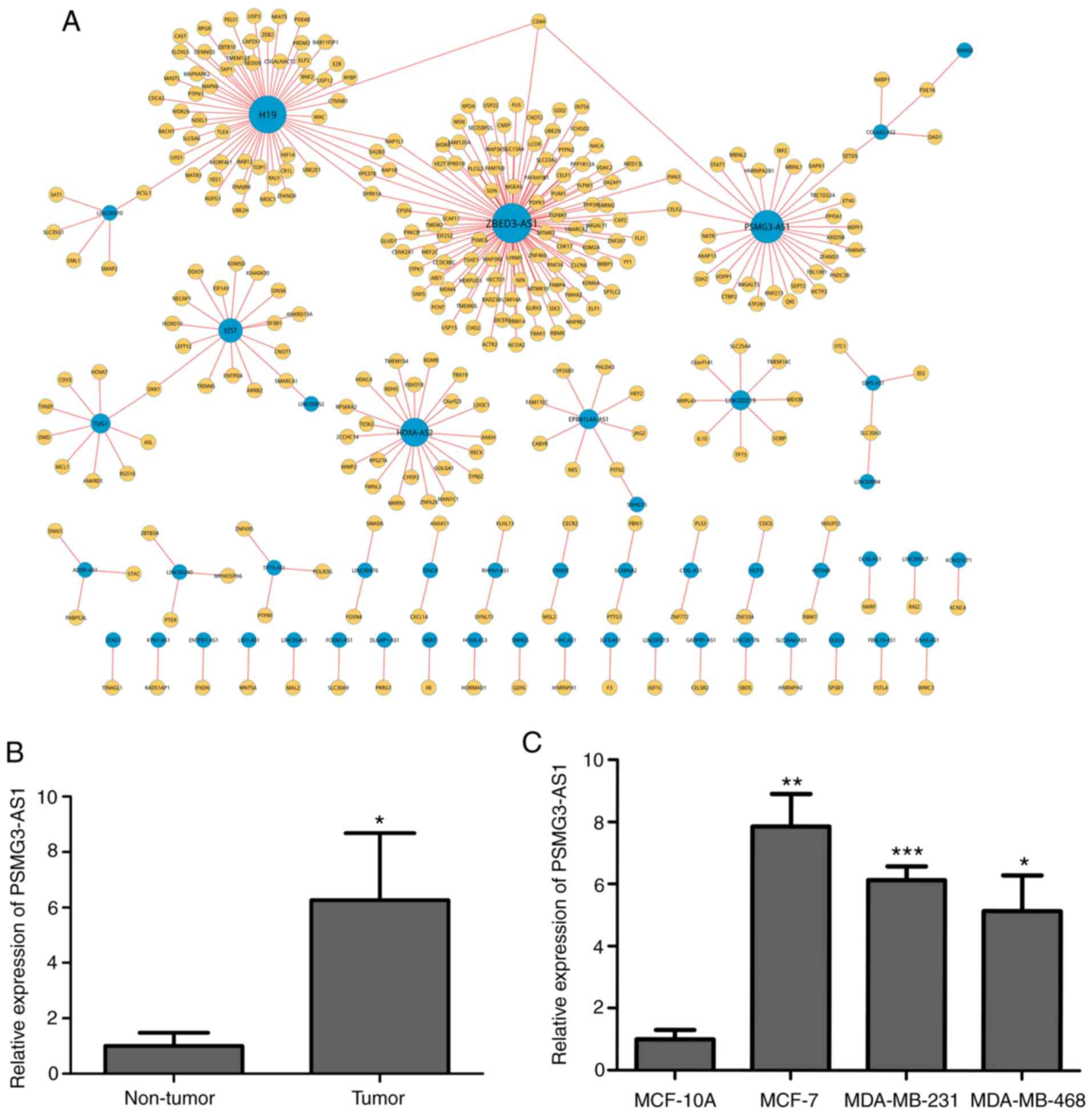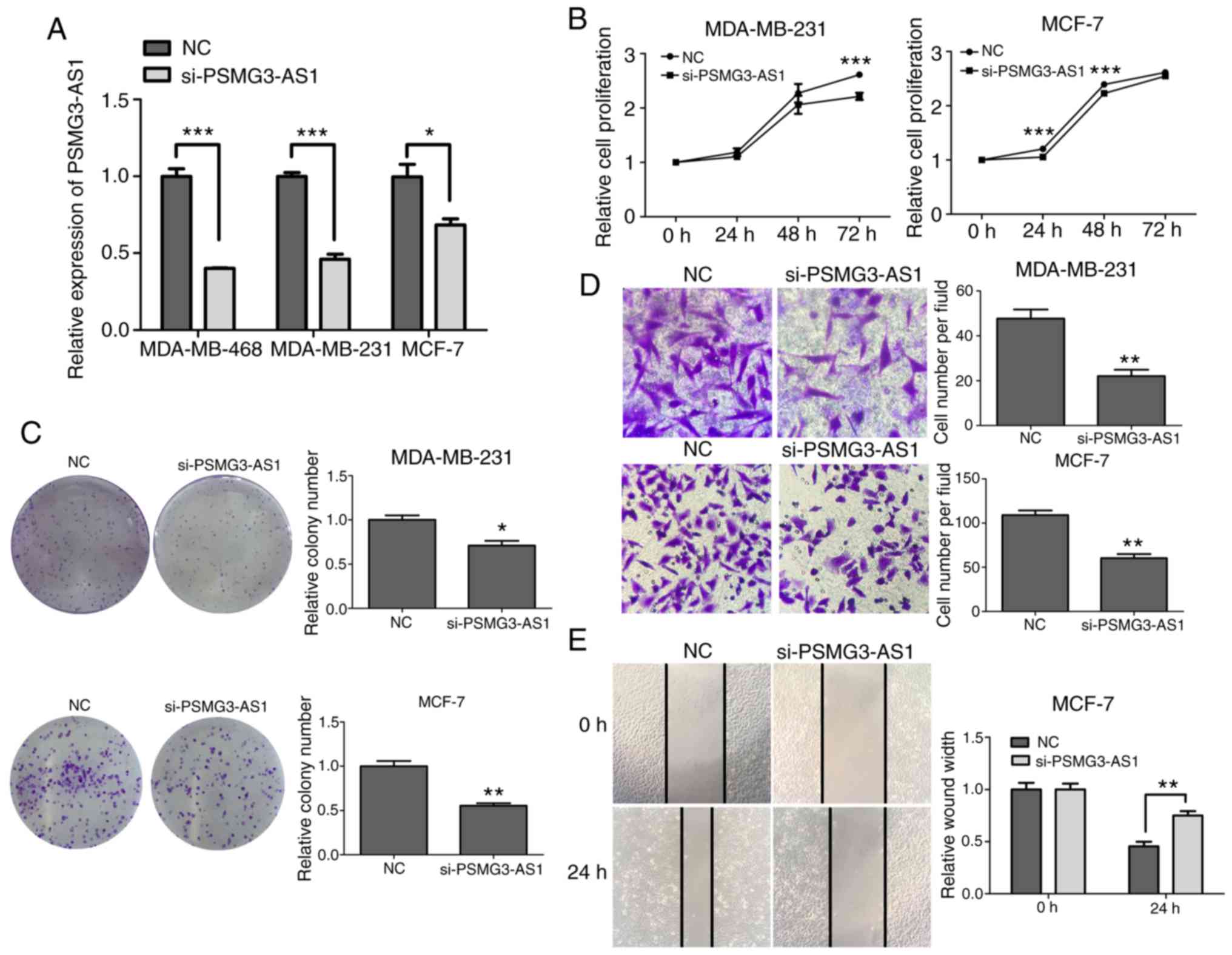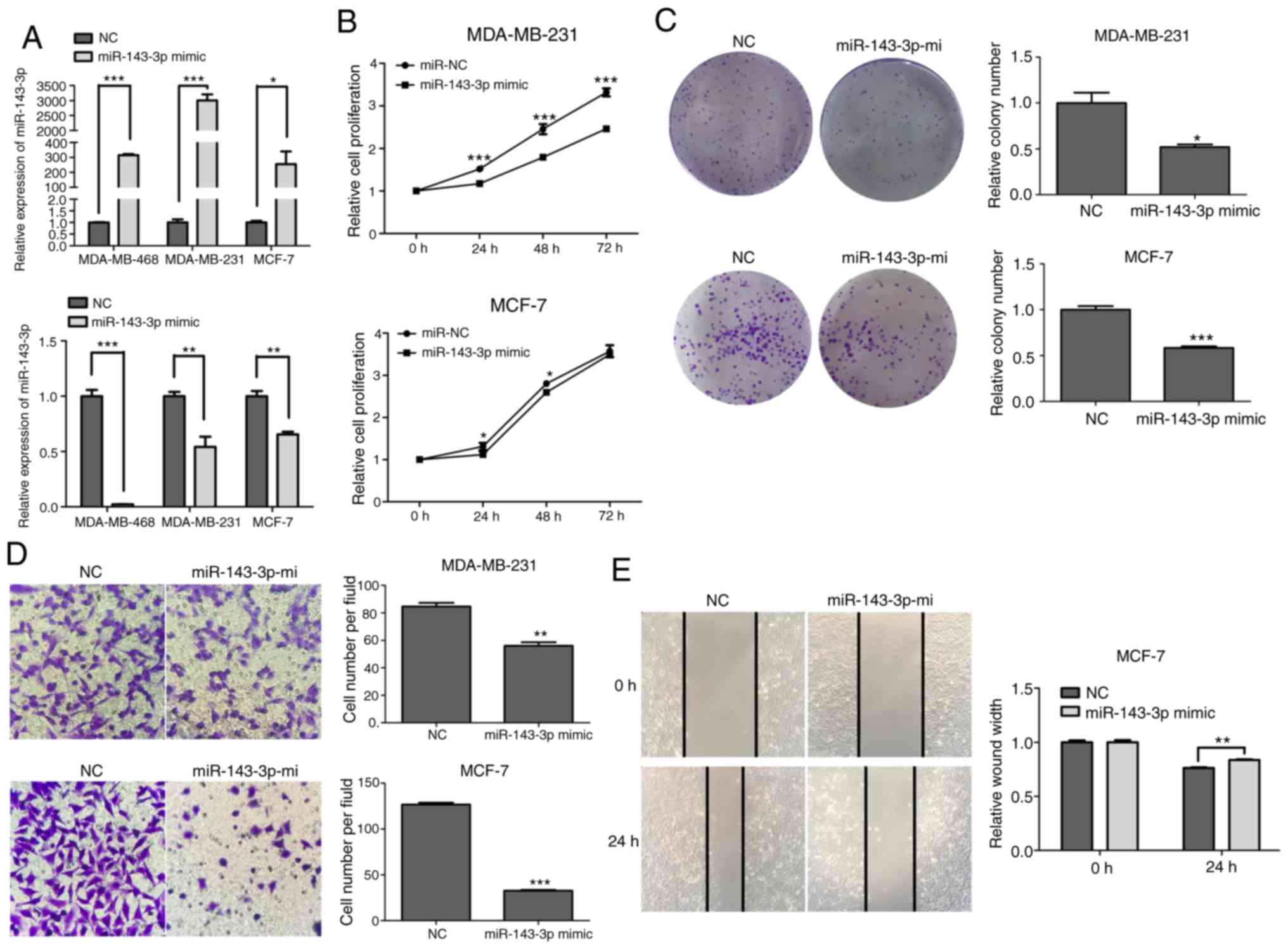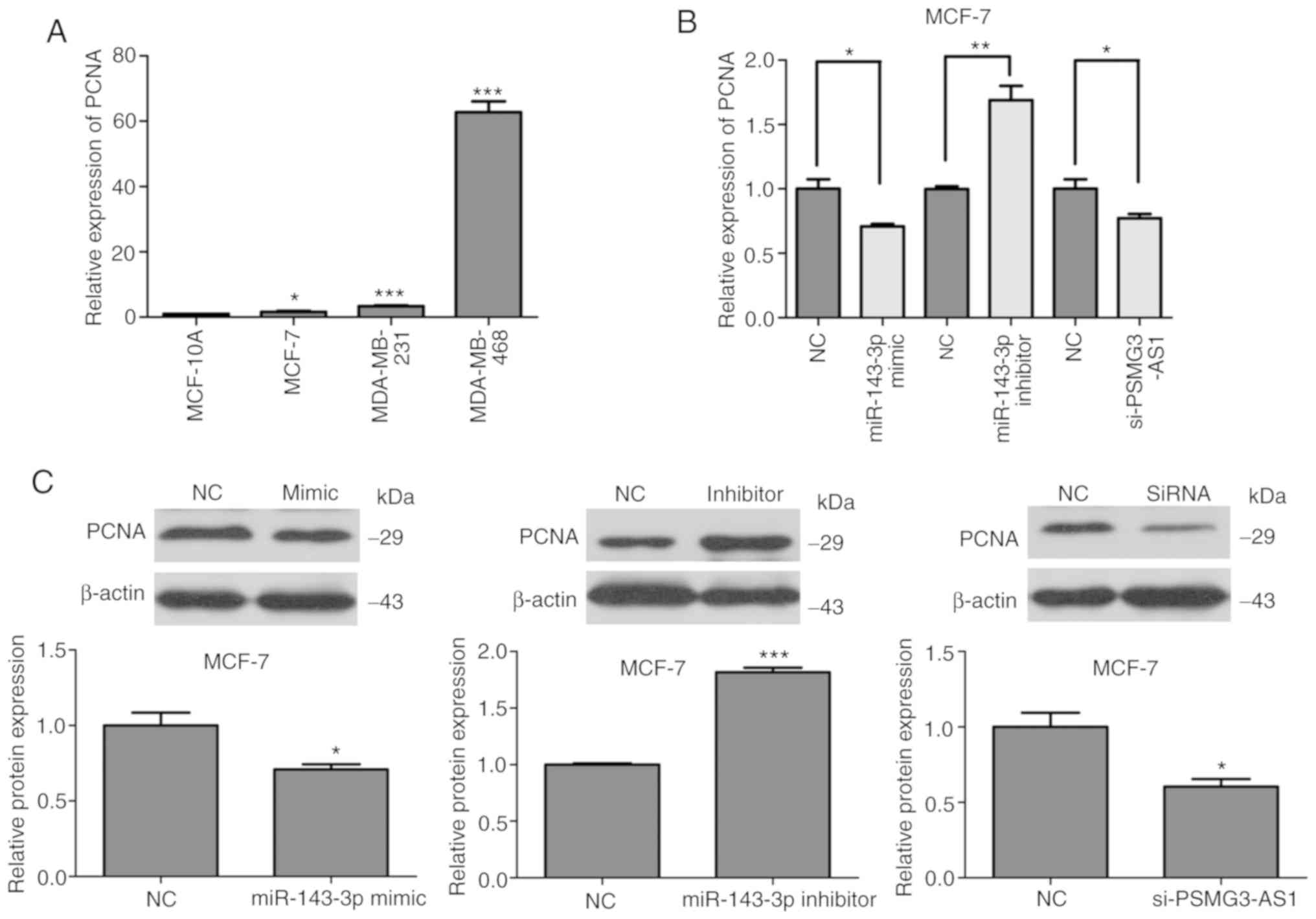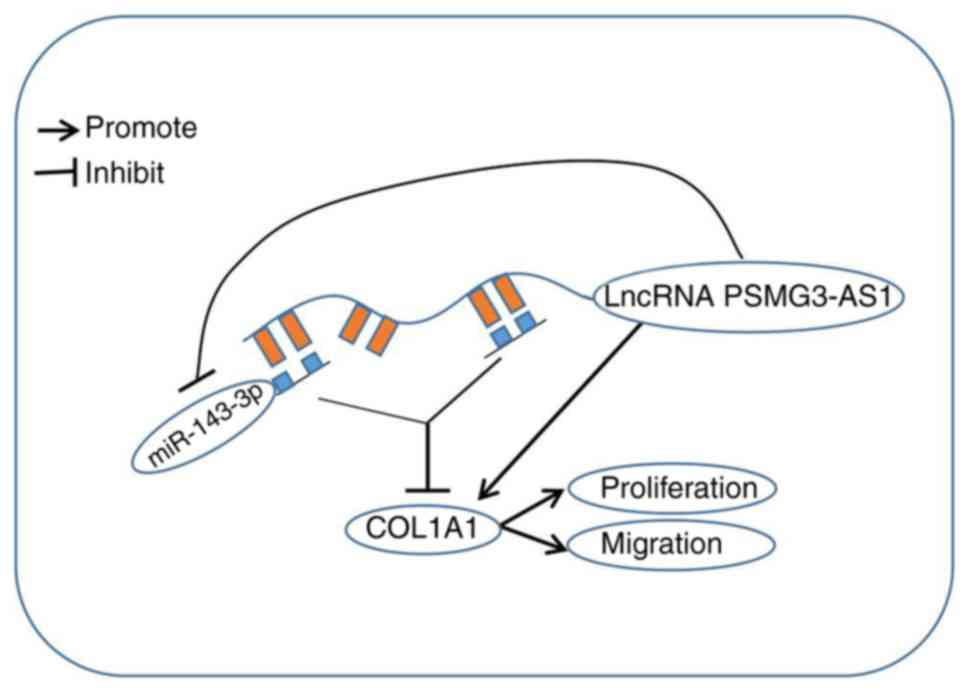Introduction
Breast cancer is recognized as the most common
malignancy in women, with high incidence and mortality rates around
the world (1,2). A study indicated that in 2018, 2.1
million individuals would be diagnosed with breast cancer,
accounting for ~25% of all cancer diagnoses in women (3). Breast cancer is the most frequently
diagnosed cancer in the majority of countries (154 out of 185) and
is the leading cause of cancer-associated mortality in >100
locations (3). Breast carcinoma ranks
second and fourth for incidence and mortality worldwide,
respectively, and has escalated as an emerging epidemic. Therefore,
determining the pathogenesis of breast cancer and developing more
effective therapeutic strategies for this disease is crucial.
Recent research has documented that non-coding RNAs,
which serve key roles in the pervasive transcription of the
mammalian genome, constitute the majority of the transcribed genome
(4,5).
It has also been previously reported that ~2% of the human genome
is associated with protein coding, while ~70–90% is transcribed
into non-coding RNAs (6). MicroRNAs
(miRNAs) and long non-coding RNAs (lncRNAs) are two significant
forms of non-coding RNAs (7,8). lncRNAs are characterized as having
>200 nucleotides, and serve an essential role in a variety of
biological processes, including cellular differentiation,
metabolism, migration and apoptosis (9). Previous research has demonstrated that
lncRNAs act as tumor promoters in breast cancer. For example,
lncROR can serve as an oncogenic factor in breast cancer cells,
leading to poor prognostic outcome (10). EZR-antisense (AS)1 was revealed to be
overexpressed in breast cancer tissues and may serve as a
prognostic marker, leading to the promotion of migration,
proliferation and invasion of breast cancer cells (11). lncRNA BLAT1 was revealed to be
increased in basal-like breast cancer through epigenetic
modifications (12). miRNAs are
highly conserved small non-coding RNAs, consisting of 18–24
nucleotides, that can inhibit translation or induce mRNA
degradation by binding to the 3′-untranslated regions (3′-UTRs) of
target genes (13). Previous research
has indicated that miR-143-3p can inhibit the proliferation,
migration and invasion of breast cancer cells (1,14).
Previous research has proposed the competing
endogenous RNAs (ceRNAs) hypothesis. This hypothesis states that
endogenous RNAs, including mRNAs, pseudogenes and lncRNAs, include
the miRNA recognition elements (MREs) that competitively combine
with common miRNAs and reduce the inhibition of miRNAs on target
genes, sequentially, increasing the expression of target genes and
regulating cell activities (15). An
increasing number of studies have demonstrated that lncRNAs can
serve as ceRNAs to regulate mRNAs by sponging target miRNAs. Some
studies have indicated that lncRNA-SNHG16 may act as a ceRNA
through sponging miR-216-5p competitively to regulate the target
gene zinc finger E-box binding homeobox 1 in cervical cancer cell
lines (16). LncRNA-SNHG16 has been
indicated to increase the expression of the gene PRMT5 by serving
as an endogenous sponge of miR-4518 in glioma cell lines (17). The HIF-2α/MALAT1/miR-216b axis has
been demonstrated to regulate the multi-drug resistance of HCC
cells by modulating autophagy (18).
The present study aimed to identify a signal axis
for the lncRNA-miRNA-mRNA interaction in breast carcinoma. The
results identified six lncRNAs to be associated with breast cancer,
including PSMG3-AS1, through preliminary bioinformatics analysis.
The present study revealed that PSMG3-AS1 was increased in breast
carcinoma cell lines and tissues. Furthermore, PSMG3-AS1 regulated
the expression of COL1A1 by sponging miR-143-3p to affect breast
carcinoma development. As a consequence, a
PSMG3-AS1/miR-143-3p/COL1A1 regulatory axis was identified in the
present study, which served a role in the pathogenic mechanism of
breast cancer, and PSMG3-AS1 may act as a potential therapeutic
target gene in breast carcinoma.
Materials and methods
Breast cancer tissue samples
The protocol of the present study conformed to the
ethical guidelines of the 1975 Declaration of Helsinki and its
later amendments. The present study was approved by the Ethics
Committee of the Fifth Affiliated Hospital of Harbin Medical
University. All participants signed informed consent, and patients
provided informed consent for undergoing the procedures and for
having data collected and analyzed for research purposes. A total
of 33 patients with breast cancer were selected between October
2016 and August 2018. Patients were aged 26–80 years, with an
average age of 56.42±11.12 years. The breast cancer tissue and
para-carcinoma tissue specimens were collected at the Fifth
Affiliated Hospital of Harbin Medical University and maintained at
−80°C for further use.
Cell lines
The normal breast epithelial cells MCF-10A and the
breast cancer cell lines MDA-MB-468, MDA-MB-231 and MCF-7 were
obtained from the American Type Culture Collection. MCF-10A cells
were cultured in MEGM (Cobioer Biosciences) with 100 ng/ml cholera
toxin. MDA-MB-468, MDA-MB-231 and MCF-7 cells were cultured in DMEM
(Sangon Biotech Co., Ltd.) supplemented with 10% fetal bovine serum
(Sangon Biotech Co., Ltd.) and 1% antibiotics (penicillin 100 U/ml;
streptomycin 100 µg/ml; Sangon Biotech Co., Ltd.). All cell
lines were cultured in an incubator at 37°C with 5%
CO2.
RNA extraction, cDNA synthesis and
reverse-transcription quantitative (RT-q) PCR
Total RNA was extracted from the tissue samples or
cells using TRIzol® reagent (Thermo Fisher Scientific,
Inc.), and the RNA concentration and purity were determined using
BioSpec-nano (Beijing Daojin Medical Appliance Co., Ltd.). The cDNA
of total RNA was synthesized using the ReverTra Ace®
qPCR RT kit (cat. no. FSQ-101; Toyobo Life Science) and the cDNA of
miR-143-3p was synthesized using the Reverse transcription kit
(Suzhou GenePharma Co., Ltd.). RT-qPCR for lncRNA PSMG3-AS1, COL1A1
and PCNA was performed using the THUNDERBIRD SYBR qPCR Mix (cat.
no. QPS-201; Toyobo Life Science), and the reaction procedure was
95°C for 1 min, followed by 40 cycles at 95°C for 15 sec, 60°C for
30 sec and 72°C for 1 min. miR-143-3p RT-qPCR was performed using
the miR-143-3p Hairpin-it™ Real-Time PCR kit, and the reaction
procedure was 95°C for 3 min, followed by 40 cycles at 95°C for 12
sec and 60°C for 40 sec. RT-qPCR was performed using a StepOnePlus
RT-qPCR instrument (Applied Biosystems; Thermo Fisher Scientific,
Inc.) and all procedures were carried out in accordance with the
manufacturer's protocol. Relative expression levels were determined
using the 2−ΔΔCq (19)
method and normalized to β-Actin and U6. The primer
sequences used were as follows. PSMG3-AS1 forward,
5′-GAAGCAGAACCAACGCACAG-3′ and reverse,
5′-GCATAATCCAATCCCTCAAGAA-3′; ACTB forward,
5′-CCTGGCACCCAGCACAAT-3′ and reverse, 5′-GGGCCGGACTCGTCATAC-3′;
miR-143-3p forward, 5′-CTGGCGTTGAGATGAAGCAC-3′ and reverse,
5′-CAGAGCAGGGTCCGAGGTA-3′; U6 forward, 5′-CGCTTCGGCAGCACATATAC-3′
and reverse, 5′-TTCACGAATTTGCGTGTCATC-3′; COL1A1 forward,
5′-GCGTGTACCCCACTCAGC-3′ and reverse, 5′-CCGAACCAGACATGCCTC-3′.
Cell transfection
miR-143-3p mimics and negative control (NC),
miR-143-3p inhibitor and NC and si-PSMG-AS1 and NC, were obtained
from Suzhou GenePharma Co., Ltd. The sequences were as follows:
miR-143-3p mimics forward, 5′-UGAGAUGAAGCACUGUAGCUC-3′ and reverse,
5′-GCUACAGUGCUUCAUCUCAUU-3′); mimics-NC forward,
5′-UUCUCCGAACGUGUCACGUTT-3′ and reverse,
5′-ACGUGACACGUUCGGAGAATT-3′); miR-143-3p inhibitor forward,
5′-GAGCUACAGUGCUUCAUCUCA-3′) and inhibitor-NC reverse,
5′-CAGUACUUUUGUGUAGUACAA-3′); si-PSMG3-AS1 forward,
5′-GGACGUCUCCCAUUCUGAATT-3′ and reverse,
5′-UUCAGAAUGGGAGACGUCCTT-3′); si-PSMG3-NC forward,
5′-UUCUCCGAACGUGUCACGUTT-3′ and reverse,
5′-ACGUGACACGUUCGGAGAATT-3′. Prior to transfection,
5×105 cells/well were seeded into six-well plates. The
RNA oligo was transfected in MDA-MB-231, MDA-MB-468 and MCF-7 cells
using Lipofectamine 2000® reagent (Invitrogen; Thermo
Fisher Scientific, Inc.) according to the manufacturer's
protocol.
Cell proliferation assay
The Cell Counting Kit (CCK)-8 assay was performed to
calculate the proliferation of the breast cancer cell lines. Cells
with different processing methods in different experimental groups
were digested and seeded in 96-well plates following transfection.
Cells were then cultured for 24, 48 and 72 h, respectively. At the
end of the experiment, 10 µl CCK-8 solution (Sangon Biotech
Co., Ltd.) was added into each well and the cells were incubated at
37°C in a humidified incubator with 5% CO2 for 2 h. The
absorbance of each well was measured at 450 nm using a microplate
reader (Sunrise; Tecan Group Ltd.). The result of relative cell
proliferation was obtained by dividing the value measured at each
time-point by the value at 0 h and setting the measured value at 0
h as 1 (20).
For the colony formation assay, 400 cells/well were
plated and after 7 days of culture, the cells were washed with PBS,
fixed with methanol and treated with 0.2% crystal violet,
respectively. The colonies containing >50 cells were counted
manually and images were obtained concurrently.
Cell migration assay
Wound-healing and Transwell assays were used to
evaluate migration of RNA oligo-treated cell lines. For the wound
healing assay, 200 µl pipette tips were used to create
scratches when cells were 90% confluent. Images were obtained at 0
and 24 h, at the same position under a microscope (Olympus Corp.)
at an ×100 magnification, to compare cell migration. For the
Transwell assay, the Transwell cups were placed in 24-well plates
(Corning, Inc.). Following treatment with RNA oligo,
5×104 cells/well were placed in the upper chamber with
200 µl DMEM (Sangon Biotech Co., Ltd.). The lower chamber
was filled with 600 µl of 10% FBS DMEM. The cells were then
cultured for 24 h. The outer surface was subsequently washed three
times with PBS, fixed with methanol for 20 min and stained with
0.2% crystal violet for 15 min at room temperature. The images were
obtained immediately after drying. The number of migrated cells
were counted in five randomly microscopic fields of view (Olympus
Corp.) at an ×400 magnification.
Western blot analysis
Total protein was isolated in cell lysis buffer for
western blot analysis and immunoprecipitation in breast cancer
cells (Beyotime Institute of Biotechnology). The proteins were
quantified using an Enhanced BCA protein Assay kit (Beyotime
Institute of Biotechnology) and equal amounts of protein lysates
were subjected to 10% SDS-PAGE and transferred to a 0.45 µm
PVDF membrane (Beyotime Institute of Biotechnology). The membranes
were then blocked with blocking buffer and incubated at room
temperature for 1 h. Membranes were subsequently incubated with
primary antibodies at 4°C overnight. Incubation with secondary
antibodies was performed at room temperature for 1 h. The primary
antibodies used were as follows: COL1A1/Collagen I rabbit
monoclonal antibody (1:750; cat. no. AF1840, rabbit anti-human),
β-actin mouse monoclonal antibody (1:1,000; cat. no. AF0003,
mouse anti-human), PCNA rabbit monoclonal antibody (1:1,000; cat.
no. AF1363, rabbit anti-human). The secondary antibodies used were
as follows: HRP-labeled goat anti-rabbit IgG (1:1,000; cat. no.
A0208; goat anti-rabbit), HRP-labeled goat anti-mouse IgG (1:2,000;
cat. no. A0216; goat anti-mouse). All antibodies were purchased
from Beyotime Institute of Biotechnology. The signals were detected
using BeyoECL Plus (Beyotime Institute of Biotechnology). Finally,
all proteins were exposed to X-ray film and the protein bands were
analyzed using ImageJ software (version 1.48; NIH; National
Institutes of Health, Bethesda, MD, USA).
Bioinformatics analysis
miRNA-mRNA interactions and lncRNA-miRNA
intersections were downloaded from starBase v2.0 (http://starbase.sysu.edu.cn/starbase2/index.php). mRNA
and lncRNA expression profiles GSE47860 of breast cancer were
downloaded [currently the chip platform suitable for this analysis
is (huex-1_0-st) Affymetrix Human Exon 1.0 ST Array], and highly
competitive lncRNA regulated subnetworks were constructed.
Potential target genes of miR-143-3p were predicted using
TargetScan (http://www.targetscan.org/vert_71/), miRDB (http://www.mirdb.org/), miRTarBase (http://mirtarbase.mbc.nctu.edu.tw/php/search.php)
and DIANA TOOLS (http://diana.imis.athena-innovation.gr/DianaTools/index.php?r=site/page&view=software).
Statistical analysis
SPSS 18.0 software (SPSS, Inc.) was used for
statistical analyses. All data are presented as the mean ± SEM from
>two independent experiments. Differences between groups were
analyzed using a Student's t-test (two groups) and a χ2
test was used to determine the correlation between the expression
of PSMG3-AS1 and clinicopathological features. P<0.05 was
considered to indicate a statistically significant result.
Results
PSMG3-AS1 is upregulated in breast
cancer tissues and cell lines
Through preliminary bioinformatics analysis six
lncRNAs were revealed to be associated with breast cancer,
including PSMG3-AS1 (Fig. 1A). To
examine PSMG3-AS1 expression in breast cancer tissues and cell
lines, a total of 33 pairs of breast cancer tissues (Tumor) and
para-carcinoma tissues (Non-tumor), and three breast cancer cell
lines (MDA-MB-468, MDA-MB-231 and MCF-7) were used to detect
PSMG3-AS1 expression. The results indicated that the expression of
PSMG3-AS1 in cancer tissues was significantly higher compared with
non-tumor tissues (P<0.05; Fig.
1B). Similarly, PSMG3-AS1 was increased in MDA-MB-468,
MDA-MB-231 and MCF-7 cell lines compared with non-metastatic human
mammary epithelial cell line MCF-10A (P<0.05; Fig. 1C). Additionally, the present study
investigated the association between the expression of PSMG3-AS1
and the clinicopathological characteristics of 33 patients with
breast cancer (Table I). The results
demonstrated that PSMG3-AS1 served a critical role in the
development of breast cancer.
 | Table I.Relationship of PSMG3-AS1 expression
with clinic pathological features in breast cancer patients. |
Table I.
Relationship of PSMG3-AS1 expression
with clinic pathological features in breast cancer patients.
|
| Variable |
|---|
|
|
|
|---|
|
| Age (years) | Tumor size | WHO grade |
|---|
|
|
|
|
|
|---|
| Expression of
lnc-PSMG3-AS1 | ≤60 | >60 | ≤5 cm | >5 cm | I–II | III |
|---|
| Low (%) | 13 (81.25) | 3 (18.
75) | 13 (81.25) | 3 (18.75) | 11 (68.75) | 5 (31.25) |
| High (%) | 10 (58.82) | 7 (41.18) | 15 (88.24) | 2 (11.76) | 14 (82.35) | 3 (17.65) |
| P-value | 0.259 | 0.656 | 0.438 |
Silencing of PSMG3-AS1 attenuates the
progression of breast cancer cells
PSMG3-AS1 was silenced in MDA-MB-468, MDA-MB-231 and
MCF-7 cell lines. RT-qPCR was performed to examine the efficiency
of PSMG3-AS1 small interfering (si)RNAs. As presented in Fig. 2, the expression of PSMG3-AS1 was
decreased in the PSMG3-AS1 siRNA-transfected groups (P<0.05;
Fig. 2A). The results of the CCK-8
and colony forming assays indicated that silencing of PSMG3-AS1
inhibited the proliferation of MDA-MB-231 and MCF-7 breast cancer
cells (P<0.05; Fig 2B and C).
Furthermore, the results of the Transwell assay demonstrated that
the migration of MDA-MB-231 and MCF-7 breast cancer cells were
significantly decreased after PSMG3-AS1 knockdown (P<0.05;
Fig. 2D), and wound-healing assay
demonstrated that the migration of MCF-7 breast cancer cells was
significantly reduced after PSMG3-AS1 knockdown (P<0.05;
Fig. 2E).
miR-143-3p is a target of PSMG3-AS1 in
breast cancer
Increasing evidence has indicated that lncRNAs may
function as ceRNAs or a molecular sponge in the regulation of a
variety of miRNA biological functions (21). The present study identified three
miRNAs, which could bind with PSMG3-AS1, from starBase v 2.0
(http://starbase.sysu.edu.cn/mirLncRNA.php), including
miR-143-3p, which has been reported to be associated with breast
cancer (1,14). In the present study, the expression of
miR-143-3p was downregulated in tumor tissues compared with
non-tumor tissues (P<0.05; Fig.
3A). miR-143-3p was also revealed to be reduced in MDA-MB-468,
MDA-MB-231 and MCF-7 breast cancer cell lines compared with MCF-10A
(P<0.05; Fig. 3B).
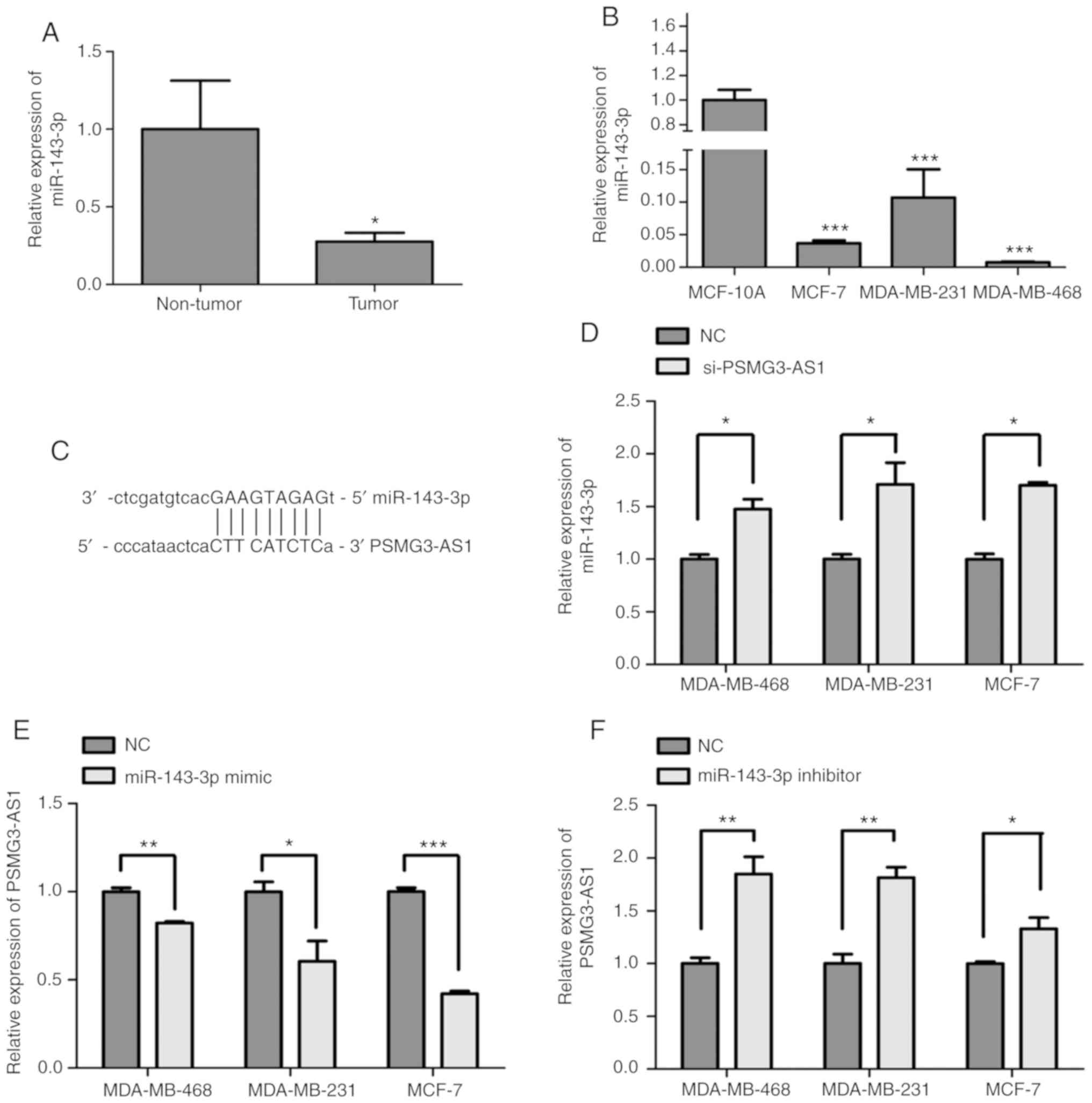 | Figure 3.miR-143-3p is identified as a target
gene of PSMG3-AS1. (A) RT-qPCR was performed to detect the
expression of miR-143-3p in tumor and non-tumor tissues. (B) The
expression of miR-143-3p in three breast cancer cell lines
(MDA-MB-468, MDA-MB-231 and MCF-7) and a normal breast epithelial
cell line MCF-10A was assessed using RT-qPCR. (C) Bioinformatics
analysis indicating the interaction of PSMG3-AS1 with miR-143-3p.
(D) Relative expression of miR-143-3p in si-NC and si-PSMG3-AS1 in
three breast cancer cell lines. (E and F) Relative expression of
PSMG3-AS1 in three breast cancer cell lines transfected with
miR-143-3p mimics, mimics-NC, miR-143-3p inhibitor and
inhibitor-NC. Error bars represented the mean ± SEM acquired from
three independent experiments. *P<0.05, **P<0.01,
***P<0.001. miR, microRNA; AS, antisense; RT-qPCR, reverse
transcription-quantitative PCR; si, small interfering; NC, negative
control. |
Whether lncRNA PSMG3-AS1 could bind with miR-143-3p
was also assessed in the present study (Fig. 3C). PSMG3-AS1 was silenced in breast
cancer cell lines MDA-MB-468, MDA-MB-231 and MCF-7, and the RT-qPCR
results revealed that miR-143-3p was significantly upregulated
compared with the NC group (P<0.05; Fig. 3D). The overexpression of miR-143-3p
downregulated the level of PSMG3-AS1, and with the inhibition of
miR-143-3p, the opposite results were obtained (P<0.05; Fig. 3E and F). Based on these results,
PSMG3-AS1 may act as a ceRNA to bind with miR-143-3p.
Overexpression or inhibition of
miR-143-3p may influence progression of breast cancer cells
miR-143-3p mimics, mimics-NC, miR-143-3p inhibitor
and inhibitor-NC were transfected into breast cancer cell lines.
RT-qPCR was performed to examine transfection efficiency (Fig. 4A). CCK-8 and colony forming assays
were used to assess cell proliferation, and Transwell and
wound-healing assays were used to assess cell migration. The
results demonstrated that the overexpression of miR-143-3p reduced
the proliferative ability of MDA-MB-231 and MCF-7 cells (Fig. 4B and C). Additionally, Transwell assay
revealed that the migratory capacities of MDA-MB-231 and MCF-7
cells were decreased (Fig. 4D), and
wound-healing assay revealed that the migratory capacity of MCF-7
cells was reduced (Fig. 4E) with
overexpression of miR-143-3p. In contrast, inhibiting miR-143-3p
significantly increased the proliferation of MDA-MB-231 and MCF-7
cell lines compared with the inhibitor-NC group (Fig. 4F and G), and Transwell assay revealed
that the migratory capacities of MDA-MB-231 and MCF-7 cells were
increased (Fig. 4H) and wound-healing
assay revealed that the migratory capacity of MCF-7 cells was
enhanced (Fig. 4I). These results
were consistent with previous research which determined this in
other tumor types (22).
miR-143-3p may serve a role in
regulating its target gene COL1A1
Using bioinformatic analysis, a total of 15
candidates were identified as common target genes for miR-143-3p
(Fig. 5A). Among these genes, COL1A1
was increased in a number of malignant tumors and had been reported
to contribute to tumor cell amplification and migration (23). The binding sites between miR-143-3p
and COL1A1 were searched using bioinformatics analysis (Fig. 5B). The mRNA expression of COL1A1 in
patient tumor tissues and breast cancer cell lines was increased,
and these results were in accordance with those for PSMG3-AS1
(Fig. 5C and D). The present study
indicated that the overexpression of miR-143-3p decreased the mRNA
expression of COL1A1 in three breast cancer cell lines (Fig. 5E). However, the inhibition of
miR-143-3p expression increased the mRNA of COL1A1 (Fig. 5F). Furthermore, the COL1A1 protein
expression level in MCF-7 cells, which were treated with miR-143-3p
mimics and inhibitor, was consistent with the COL1A1 mRNA
expression level (Fig. 5G). In the
present study, silencing of PSMG3-AS1 in breast cancer cells was
revealed to reduce COL1A1 mRNA and protein expression (Fig. 5H and I). Therefore, the present study
demonstrated that PSMG3-AS1 could regulate COL1A1 by binding with
miR-143-3p.
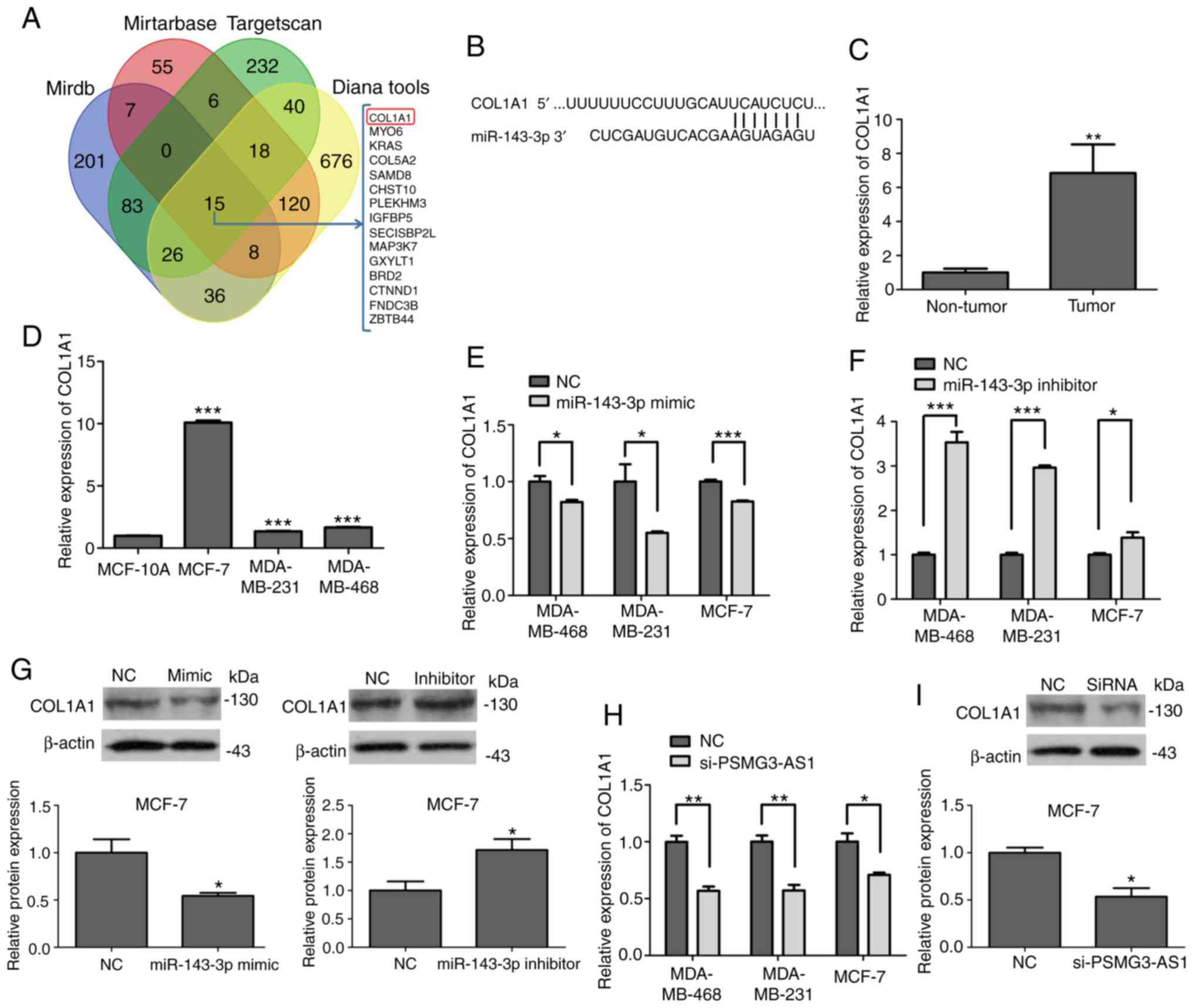 | Figure 5.COL1A1 is identified as a target gene
of miR-143-3p. (A) A Venn diagram presenting 4 software databases
which predicted miRNA targets and identified 15 candidate genes
that may interact with miR-143-3p. (B) A putative miR-143-3p site
exists in the 3′-UTR of the COL1A1 mRNA. (C) The relative mRNA
expression of COL1A1 in breast cancer tissues and adjacent
cancerous tissues. (D) The relative mRNA expression of COL1A1 in
three breast cancer cell lines (MDA-MB-468, MDA-MB-231 and MCF-7)
and a normal breast epithelial cell line MCF-10A. (E and F) mRNA
expression of COL1A1 in MDA-MB-468, MDA-MB-231 and MCF-7 cell lines
transfected with miR-143-3p mimics, mimics-NC, miR-143-3p inhibitor
or inhibitor-NC. (G) The COL1A1 protein expression in MCF-7 cells
treated with miR-143-3p mimics and inhibitor. (H and I) Silencing
of PSMG3-AS1 in MCF-7 cells reduced the mRNA and protein expression
of COL1A1. *P<0.05, **P<0.01, ***P<0.001. COL1A1, collagen
type 1 alpha 1; miR, microRNA; UTR, untranslated region; NC,
negative control; si, small interfering; AS, antisense. |
The expression of the cell
proliferation marker PCNA is consistent with that of PSMG3-AS1
It is well established that PCNA is a cell
proliferation-associated protein and manifests its expression
during the cell division of normal and neoplastic cells (24). The cell proliferation marker PCNA
expression is associated with the genesis and development of a
variety of cancer types, including breast cancer (25) and gastric cancer (26). In the present study, PCNA mRNA
expression was upregulated in three breast cancer cell lines
compared with MCF-10A cells (Fig.
6A). This result was consistent with the results of PSMG3-AS1.
Furthermore, the results also indicated that in the MCF-7 breast
cancer cell line, the mRNA and protein expression of PCNA was
consistent with PSMG3-AS1 after transfection with PSMG3-AS1 siRNAs,
miR-143-3p mimics and miR-143-3p inhibitor (Fig. 6B and C). Therefore, it can be
concluded that lncRNA PSMG3-AS1 may serve as a tumor promoter in
breast cancer, and may combine with miR-143-3p to increase the
expression of COL1A1.
Discussion
Breast cancer is a type of malignant tumor, and is
the most common cancer among women (2). Currently, combined with early diagnoses,
radical surgery with adjuvant therapy could decrease breast
cancer-associated mortality rates (27). However, breast cancer is still the
most common gynecologic cancer. Multiple studies have demonstrated
that lncRNAs are deregulated in a variety of human cancer types,
including breast cancer (28,29), bladder cancer (30,31),
glioma (17,32), lung cancer (33) and hepatocellular cancer (18,34).
Recently, studies have indicated that lncRNAs serve a role in a
variety of biological processes, including in chromatin
modification, transcriptional regulation, genomic imprinting and
the regulation of protein function (9,35). Studies
have explored the abnormal expression of lncRNAs and their
association with tumor initiation, growth and metastasis in tumor
cells. Zhao et al (36)
indicated that SNHG16 knockdown inhibited metastasis, proliferation
and vasoformation of HemECs. Katsushima et al (37) revealed that the inhibition of TUG1 by
siRNA reduced cell proliferation in glioma stem cells. Zhou et
al (38) indicated that lncRNA
H19 may serve an essential role in tumor metastasis, and that
lncRNA H19 expression was correlated with metastasis in human
breast cancer. Due to this, it can be concluded that lncRNAs may be
used as diagnostic markers of metastatic tumors, and exhibit great
clinical importance.
In the present study, a total of six lncRNAs (H19,
XIST, TUG1, HOXA-AS2, ZBED3-AS1 and PSMG3-AS1) were screened using
bioinformatics analysis. To date, little research has been
performed assessing the role of lncRNAs in tumors, especially
regarding the mechanism of PSMG3-AS1 in breast cancer. Therefore,
the present study focused on determining PSMG3-AS1 expression.
PSMG3-AS1 was demonstrated to be upregulated in breast cancer tumor
tissues and breast cancer cell lines, suggesting it may serve an
important role in the progression of breast cancer. The results
indicated that knockdown of PSMG3-AS1 inhibited breast cancer cell
proliferation and migration. CCK-8 and colony forming assays
revealed that cell proliferation ability was reduced, and both
Transwell and wound-healing assays indicated that migratory
capacities were decreased. The mRNA and protein expression of cell
proliferation marker PCNA were consistent with PSMG3-AS1. In
summary, PSMG3-AS1 may serve a role in promoting tumor formation in
breast cancer.
Bioinformatics analysis indicated that the
miR-143-3p was a direct target gene of PSMG3-AS1, and previous
research had indicated that miR-143-3p inhibited the progression of
breast cancer cells and osteosarcoma cells (1,22). In the
present study, miR-143-3p expression was reduced in breast cancer
tissues and cell lines. Silencing of PSMG3-AS1 in breast cancer
cells increased the expression level of miR-143-3p, and
overexpression of miR-143-3p decreased the expression levels of
PSMG3-AS1 and inhibited breast cancer cell proliferation and
migration. Additionally, the opposite results were obtained after
inhibition of miR-143-3p. Recent studies have demonstrated that
COL1A1 promotes the metastasis of breast cancer and is a potential
therapeutic target gene (39). The
results of the present study revealed that COL1A1 is the target
gene of miR-143-3p, which was identified using bioinformatics
analysis. Overexpression of miR-143-3p may downregulate the mRNA
and protein expression of COL1A1, and inhibition of miR-143-3p may
induce the opposite experimental results.
The results of the present study indicated that
lncRNA (PSMG3-AS1)-miRNA (miR-143-3p)-mRNA (COL1A1) may act as a
signal axis in breast cancer. One of the main effects of lncRNAs is
to act as a sponge for miRNAs, and to reduce the expression and
activity of miRNAs (16). miRNAs
serve a regulatory role by directly binding to target genes
(40). The present study indicated
that PSMG3-AS1 regulated the target gene COL1A1 of miR-143-3p by
sponging miR-143-3p (Fig. 7). This
correlation between PSMG3-AS1 and miR-143-3p highlighted the
lncRNA-based mechanisms underlying diverse aspects of
tumorigenesis. The present study is helpful in providing a novel
therapeutic strategy for use in the treatment of breast cancer.
In summary, a PSMG3-AS1-miR-143-3p-COL1A1 regulatory
axis in breast cancer was indicated in the present study. PSMG3-AS1
served as an oncogenic lncRNA that facilitated the genesis and
development of breast cancer, by functioning as a ceRNA, which
regulated the expression of COL1A1, and also through directly
sponging miR-143-3p. In the present study, PSMG3-AS1 was indicated
to be a new potential therapeutic target in breast carcinoma
treatment. In vivo studies have revealed the important role
of lncRNAs and miRNAs in tumors. For example, H19 was revealed to
be associated with tumor development, progression, metastasis and
drug resistance (41), and silencing
of MALAT1 suppressed the proliferation of GSCs and in vivo
tumor growth by upregulating miR-129 and inhibiting SOX2 (42).
However, there are some limitations in the present
study: First, the sample size was only 33 cases, which was
relatively small. Second, breast cancer cell lines and tissue
samples from patients with breast cancer were assessed, however,
the present research lacks analysis between expression and clinical
course including genetic backgrounds, hormone receptor expression,
chemo-sensitivity, local/distant relapse and prognosis. In Fig. 5D although the mRNA expression of
COL1A1 in breast cancer cell lines was revealed to be increased
compared with MCF-10A cells, its expression was higher in MCF-7
cells compared to the other 2 cell lines, which reflects the
cell-line specific differences. In Fig.
3B, the level of miR-143-3p was reduced in all 3 cell lines
however the reduction was less in MDA-MB-231 cells. It was
speculated that different genetic backgrounds and receptor
expression of these different cell lines may play a role. Third,
experimental in vivo data were not collected in the present
study. Therefore, future studies should increase the sample size
and validate the function of the PSMG3-AS1-miR-143-3p-COL1A1
signaling axis in vivo. Selective inhibition and
overexpression of PSMG3-AS1 and miR-143-3p should be performed to
further study the effects of these two genes on the occurrence and
development of tumors, hormone receptor expression,
chemo-sensitivity, local/distant relapse and prognosis in
vivo, and further assessment of the function of PSMG3-AS1
derived from different cell lines with a variety of genetic
background is still required to a provide strong experimental basis
for clinical practice.
Acknowledgements
Not applicable.
Funding
The present study was supported, in part, by the
Fifth Affiliated Hospital of Harbin Medical University, Health
Commission of Heilongjiang Province (grant no. 2017-183), the
National Natural Science Foundation of China (grant no. 81503069),
the University Nursing Program for Young Scholars with Creative
Talents in Heilongjiang Province (grant no. UNPYSCT-2016040), the
Natural Science Foundation of Heilongjiang Province (grant no.
QC2016112), the Traditional Chinese Medicine Administration of
Heilongjiang Province (grant no. IQG-050) and the Fundamental
Research Funds for the Central Universities (grant no.
21619347).
Availability of data and materials
The datasets used and/or analyzed during the present
study are available from the corresponding author on reasonable
request.
Authors' contributions
YC performed all of the experiments. DY and YF
designed the study and wrote the manuscript. GZ, QZ, YC and YB
collected the tissue samples and participated in the statistical
analysis and helped to draft the manuscript. ZY, GC, XP and FG
participated in RNA extraction. JW and YB performed the western
blot assay. All authors read and approved the final manuscript and
agree to be accountable for all aspects of the research in ensuring
that accuracy or integrity of any parts of the work are
appropriately investigated and resolved.
Ethics approval and consent to
participate
The present study was approved by the Ethics
Committee of the Fifth Affiliated Hospital of Harbin Medical
University and all the participants signed informed consent. All
patients provided informed consent to undergo the procedures and
for having their data collected and analyzed for research
purposes.
Patient consent for publication
Not applicable.
Competing interests
The authors declare that they have no competing
interests.
References
|
1
|
Xia C, Yang Y, Kong F, Kong Q and Shan C:
MiR-143-3p inhibits the proliferation, cell migration and invasion
of human breast cancer cells by modulating the expression of MAPK7.
Biochimie. 147:98–104. 2018. View Article : Google Scholar : PubMed/NCBI
|
|
2
|
Donepudi MS, Kondapalli K, Amos SJ and
Venkanteshan P: Breast cancer statistics and markers. J Cancer Res
Ther. 10:506–511. 2014.PubMed/NCBI
|
|
3
|
Bray F, Ferlay J, Soerjomataram I, Siegel
RL, Torre LA and Jemal A: Global cancer statistics 2018: GLOBOCAN
estimates of incidence and mortality worldwide for 36 cancers in
185 countries. CA Cancer J Clin. 68:394–424. 2018. View Article : Google Scholar : PubMed/NCBI
|
|
4
|
Chan JJ and Tay Y: Noncoding RNA:RNA
regulatory networks in cancer. Int J Mol Sci. 19:E13102018.
View Article : Google Scholar : PubMed/NCBI
|
|
5
|
Carninci P, Kasukawa T, Katayama S, Gough
J, Frith MC, Maeda N, Oyama R, Ravasi T, Lenhard B, Wells C, et al:
The transcriptional landscape of the mammalian genome. Science.
309:1559–1563. 2005. View Article : Google Scholar : PubMed/NCBI
|
|
6
|
Soudyab M, Iranpour M and Ghafouri-Fard S:
The role of long non-coding RNAs in breast cancer. Arch Iran Med.
19:508–517. 2016.PubMed/NCBI
|
|
7
|
Greco S, Gorospe M and Martelli F:
Noncoding RNA in age-related cardiovascular diseases. J Mol Cell
Cardiol. 83:142–155. 2015. View Article : Google Scholar : PubMed/NCBI
|
|
8
|
Carthew RW and Sontheimer EJ: Origins and
mechanisms of miRNAs and siRNAs. Cell. 136:642–655. 2009.
View Article : Google Scholar : PubMed/NCBI
|
|
9
|
Wapinski O and Chang HY: Long noncoding
RNAs and human disease. Trends Cell Biol. 21:354–361. 2011.
View Article : Google Scholar : PubMed/NCBI
|
|
10
|
Hou L, Tu J, Cheng F, Yang H, Yu F, Wang
M, Liu J, Fan J and Zhou G: Long noncoding RNA ROR promotes breast
cancer by regulating the TGF-β pathway. Cancer Cell Int.
18:1422018. View Article : Google Scholar : PubMed/NCBI
|
|
11
|
Bai Y, Zhou X, Huang L, Wan Y, Li X and
Wang Y: Long noncoding RNA EZR-AS1 promotes tumor growth and
metastasis by modulating Wnt/β-catenin pathway in breast cancer.
Exp Ther Med. 16:2235–2242. 2018.PubMed/NCBI
|
|
12
|
Han YJ, Boatman SM, Zhang J, Du XC, Yeh
AC, Zheng Y, Mueller J and Olopade OI: LncRNA BLAT1 is upregulated
in basal-like breast cancer through epigenetic modifications. Sci
Rep. 8:155722018. View Article : Google Scholar : PubMed/NCBI
|
|
13
|
Liang Y, Xu X, Wang T, Li Y, You W, Fu J,
Liu Y, Jin S, Ji Q, Zhao W, et al: The EGFR/miR-338-3p/EYA2 axis
controls breast tumor growth and lung metastasis. Cell Death Dis.
8:e29282017. View Article : Google Scholar : PubMed/NCBI
|
|
14
|
Li D, Hu J, Song H, Xu H, Wu C, Zhao B,
Xie D, Wu T, Zhao J and Fang L: MiR-143-3p targeting LIM domain
kinase 1 suppresses the progression of triple-negative breast
cancer cells. Am J Transl Res. 9:2276–2285. 2017.PubMed/NCBI
|
|
15
|
Salmena L, Poliseno L, Tay Y, Kats L and
Pandolfi PP: A ceRNA hypothesis: The rosetta stone of a hidden RNA
language? Cell. 146:353–358. 2011. View Article : Google Scholar : PubMed/NCBI
|
|
16
|
Zhu H, Zeng Y, Zhou CC and Ye W:
SNHG16/miR-216-5p/ZEB1 signal pathway contributes to the
tumorigenesis of cervical cancer cells. Arch Biochem Biophys.
637:1–8. 2018. View Article : Google Scholar : PubMed/NCBI
|
|
17
|
Lu YF, Cai XL, Li ZZ, Lv J, Xiang YA, Chen
JJ, Chen WJ, Sun WY, Liu XM and Chen JB: LncRNA SNHG16 functions as
an oncogene by sponging MiR-4518 and up-regulating PRMT5 expression
in glioma. Cell Physiol Biochem. 45:1975–1985. 2018. View Article : Google Scholar : PubMed/NCBI
|
|
18
|
Yuan P, Cao W, Zang Q, Li G, Guo X and Fan
J: The HIF-2α-MALAT1-miR-216b axis regulates multi-drug resistance
of hepatocellular carcinoma cells via modulating autophagy. Biochem
Biophys Res Commun. 478:1067–1073. 2016. View Article : Google Scholar : PubMed/NCBI
|
|
19
|
Livak KJ and Schmittgen TD: Analysis of
relative gene exp ression data using real-time quantitative PCR and
the 2(-Delta Delta C(T)) method. Methods. 25:402–408. 2001.
View Article : Google Scholar : PubMed/NCBI
|
|
20
|
Yue B, Cai D, Liu C, Fang C and Yan D:
Linc00152 functions as a competing endogenous RNA to confer
oxaliplatin resistance and holds prognostic values in colon cancer.
Mol Ther. 24:2064–2077. 2016. View Article : Google Scholar : PubMed/NCBI
|
|
21
|
Guil S and Esteller M: RNA-RNA
interactions in gene regulation: The coding and noncoding players.
Trends Biochem Sci. 40:248–256. 2015. View Article : Google Scholar : PubMed/NCBI
|
|
22
|
Sun X, Dai G, Yu L, Hu Q, Chen J and Guo
W: MiR-143-3p inhibits the proliferation, migration and invasion in
osteosarcoma by targeting FOSL2. Sci Rep. 8:6062018. View Article : Google Scholar : PubMed/NCBI
|
|
23
|
Zhang Z, Fang C, Wang Y, Zhang J, Yu J,
Zhang Y, Wang X and Zhong J: COL1A1: A potential therapeutic target
for colorectal cancer expressing wild-type or mutant KRAS. Int J
Oncol. 53:1869–1880. 2018.PubMed/NCBI
|
|
24
|
Jurikova M, Danihel L, Polak S and Varga
I: Ki67, PCNA, and MCM proteins: Markers of proliferation in the
diagnosis of breast cancer. Acta Histochem. 118:544–552. 2016.
View Article : Google Scholar : PubMed/NCBI
|
|
25
|
Guo JL, Gu SQ, Li Y and Zhang XY:
Evaluation of clinical significance of endoglin expression during
breast cancer and its correlation with ER and PCNA. Eur Rev Med
Pharmacol Sci. 21:5402–5407. 2017.PubMed/NCBI
|
|
26
|
Hu L, Li HL, Li WF, Chen JM, Yang JT, Gu
JJ and Xin L: Clinical significance of expression of proliferating
cell nuclear antigen and E-cadherin in gastric carcinoma. World J
Gastroenterol. 23:3721–3729. 2017. View Article : Google Scholar : PubMed/NCBI
|
|
27
|
Ahmed M, Rubio IT, Klaase JM and Douek M:
Surgical treatment of nonpalpable primary invasive and in situ
breast cancer. Nat Rev Clin Oncol. 12:645–663. 2015. View Article : Google Scholar : PubMed/NCBI
|
|
28
|
Lee J, Park HY, Kim WW, Lee SJ, Jeong JH,
Kang SH, Jung JH and Chae YS: Biological function of long noncoding
RNA snaR in HER2-positive breast cancer cells. Tumour Biol.
39:10104283177073742017. View Article : Google Scholar : PubMed/NCBI
|
|
29
|
Gupta RA, Shah N, Wang KC, Kim J, Horlings
HM, Wong DJ, Tsai MC, Hung T, Argani P, Rinn JL, et al: Long
non-coding RNA HOTAIR reprograms chromatin state to promote cancer
metastasis. Nature. 464:1071–1076. 2010. View Article : Google Scholar : PubMed/NCBI
|
|
30
|
Tan J, Qiu K, Li M and Liang Y:
Double-negative feedback loop between long non-coding RNA TUG1 and
miR-145 promotes epithelial to mesenchymal transition and
radioresistance in human bladder cancer cells. FEBS Lett.
589:3175–3181. 2015. View Article : Google Scholar : PubMed/NCBI
|
|
31
|
Peter S, Borkowska E, Drayton RM, Rakhit
CP, Noon A, Chen W and Catto JW: Identification of differentially
expressed long noncoding RNAs in bladder cancer. Clin Cancer Res.
20:5311–5321. 2014. View Article : Google Scholar : PubMed/NCBI
|
|
32
|
Li H, Yuan X, Yan D, Li D, Guan F, Dong Y,
Wang H, Liu X and Yang B: Long Non-Coding RNA MALAT1 decreases the
sensitivity of resistant glioblastoma cell lines to temozolomide.
Cell Physiol Biochem. 42:1192–1201. 2017. View Article : Google Scholar : PubMed/NCBI
|
|
33
|
Zeng Z, Bo H, Gong Z, Lian Y, Li X, Li X,
Zhang W, Deng H, Zhou M, Peng S, et al: AFAP1-AS1, a long noncoding
RNA upregulated in lung cancer and promotes invasion and
metastasis. Tumour Biol. 37:729–737. 2016. View Article : Google Scholar : PubMed/NCBI
|
|
34
|
Wang F, Yang H, Deng Z, Su Y, Fang Q and
Yin Z: HOX antisense lincRNA HOXA-AS2 promotes tumorigenesis of
hepatocellular carcinoma. Cell Physiol Biochem. 40:287–296. 2016.
View Article : Google Scholar : PubMed/NCBI
|
|
35
|
Guttman M, Amit I, Garber M, French C, Lin
MF, Feldser D, Huarte M, Zuk O, Carey BW, Cassady JP, et al:
Chromatin signature reveals over a thousand highly conserved large
non-coding RNAs in mammals. Nature. 458:223–227. 2009. View Article : Google Scholar : PubMed/NCBI
|
|
36
|
Zhao W, Fu H, Zhang S, Sun S and Liu Y:
LncRNA SNHG16 drives proliferation, migration, and invasion of
hemangioma endothelial cell through modulation of miR-520d-3p/STAT3
axis. Cancer Med. 29:102018.
|
|
37
|
Katsushima K, Natsume A, Ohka F, Shinjo K,
Hatanaka A, Ichimura N, Sato S, Takahashi S, Kimura H, Totoki Y, et
al: Targeting the notch-regulated non-coding RNA TUG1 for glioma
treatment. Nat Commun. 7:136162016. View Article : Google Scholar : PubMed/NCBI
|
|
38
|
Zhou W, Ye XL, Xu J, Cao MG, Fang ZY, Li
LY, Guan GH, Liu Q, Qian YH and Xie D: The lncRNA H19 mediates
breast cancer cell plasticity during EMT and MET plasticity by
differentially sponging miR-200b/c and let-7b. Sci Signal.
10:4832017. View Article : Google Scholar
|
|
39
|
Liu J, Shen JX, Wu HT, Li XL, Wen XF, Du
CW and Zhang GJ: Collagen 1A1 (COL1A1) promotes metastasis of
breast cancer and is a potential therapeutic target. Discov Med.
25:211–223. 2018.PubMed/NCBI
|
|
40
|
Kobayashi M, Saito A, Tanaka Y, Michishita
M, Kobayashi M, Irimajiri M, Kaneda T, Ochiai K, Bonkobara M,
Takahashi K, et al: MicroRNA expression profiling in canine
prostate cancer. J Vet Med Sci. 79:719–725. 2017. View Article : Google Scholar : PubMed/NCBI
|
|
41
|
Zheng ZG, Xu H, Suo SS, Xu XL, Ni MW, Gu
LH, Chen W, Wang LY, Zhao Y, Tian B and Hua YJ: The essential role
of H19 contributing to cisplatin resistance by regulating
glutathione metabolism in high-grade serous ovarian cancer. Sci
Rep. 6:260932016. View Article : Google Scholar : PubMed/NCBI
|
|
42
|
Xiong Z, Wang L and Wang Q: LncRNA
MALAT1/miR-129 axis promotes glioma tumorigenesis by targeting
SOX2. J Cell Mol Med. 29:102018.
|















